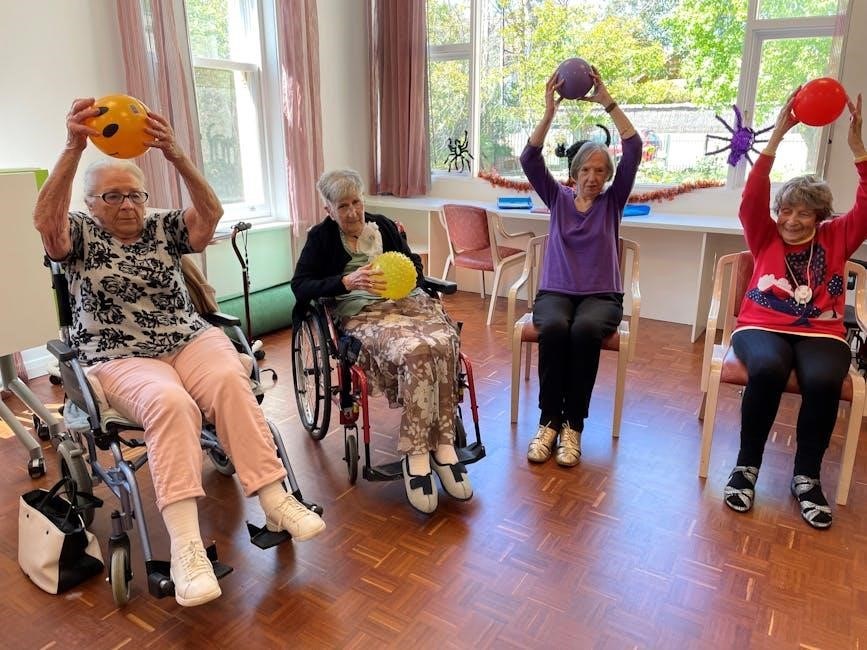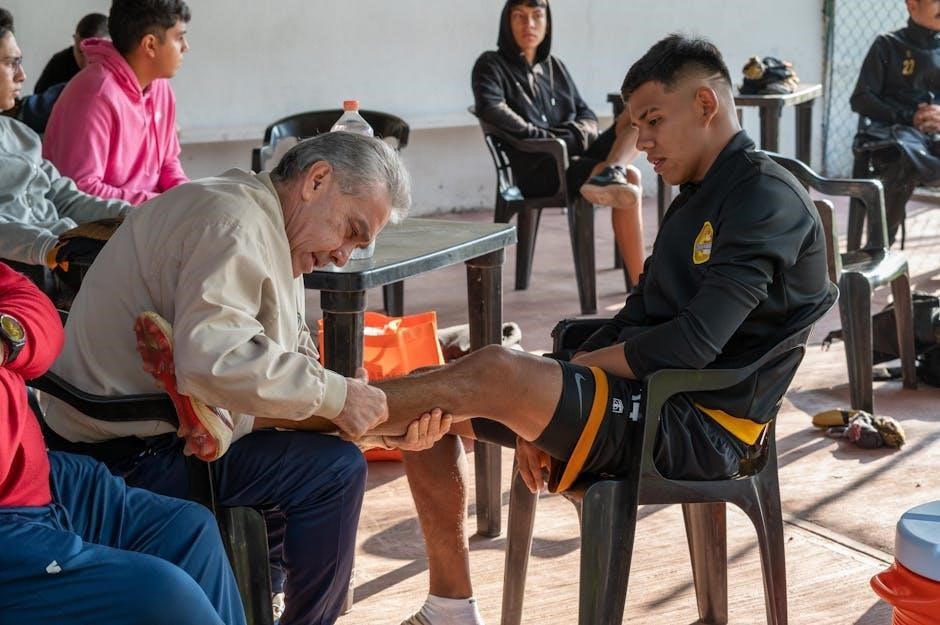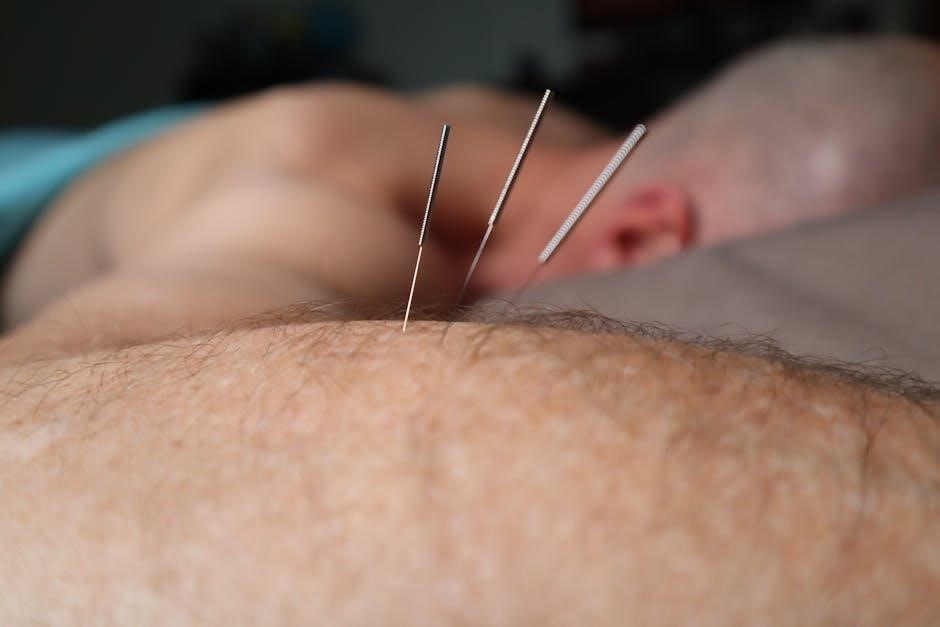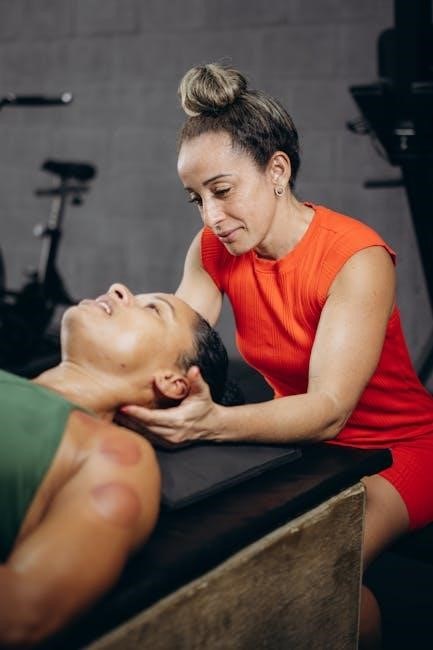Complex Regional Pain Syndrome (CRPS) is a chronic pain condition affecting limbs‚ characterized by pain‚ inflammation‚ and movement dysfunction. Physical therapy plays a crucial role in managing CRPS‚ focusing on early mobilization‚ exercises‚ and improving functional abilities to restore mobility and quality of life.

1.1 Definition and Overview of CRPS
Complex Regional Pain Syndrome (CRPS) is a chronic pain condition characterized by intense‚ burning pain in one or more limbs. It often follows an injury‚ surgery‚ or trauma‚ leading to inflammation‚ swelling‚ and movement dysfunction. CRPS is divided into two types: Type I (without nerve damage) and Type II (with nerve injury). Symptoms include hypersensitivity‚ limited range of motion‚ and vasomotor changes. Early intervention is critical to prevent progression and improve functional outcomes. Physical therapy plays a central role in managing CRPS‚ focusing on pain reduction‚ mobility restoration‚ and enhancing quality of life through tailored exercises and interventions.
1.2 The Role of Physical Therapy in CRPS Management
Physical therapy is essential in managing CRPS‚ focusing on improving mobility‚ reducing pain‚ and restoring functional abilities. Early mobilization and movement therapy are critical to prevent contractures and maintain joint function. Techniques such as pain exposure physical therapy (PEPT) and aerobic exercise are effective in reducing pain and improving gait. Physical therapy also addresses pain-avoidance behavior‚ encouraging gradual exposure to movements that patients may fear. By combining these approaches‚ physical therapy helps patients regain independence and improve their quality of life‚ making it a cornerstone of CRPS management.

Pathophysiology of CRPS
CRPS involves abnormal nervous system activity‚ inflammation‚ and vascular dysfunction‚ leading to chronic pain and tissue damage. Understanding these mechanisms aids in targeted therapeutic approaches.
2.1 Nervous System Involvement
CRPS is characterized by abnormal nervous system activity‚ including neurogenic inflammation and dysregulation of the autonomic nervous system. This leads to chronic pain‚ hyperalgesia‚ and allodynia. The central nervous system’s sensitization exacerbates symptoms‚ while peripheral nerve dysfunction contributes to inflammation and tissue damage. These mechanisms create a vicious cycle of pain and disability‚ necessitating targeted therapies to restore neural balance and reduce discomfort.

2.2 Inflammatory and Vascular Mechanisms
CRPS involves significant inflammatory and vascular changes‚ with elevated pro-inflammatory cytokines contributing to pain and swelling. Increased blood vessel permeability leads to edema‚ while reduced blood flow exacerbates tissue damage. The vascular system plays a key role in perpetuating pain and inflammation‚ with impaired microcirculation affecting oxygen delivery. These mechanisms are closely linked to the nervous system’s dysfunction‚ creating a cycle of inflammation and pain. Addressing these processes is critical in managing CRPS‚ often requiring a combination of physical therapy and medical interventions to restore normal blood flow and reduce inflammation.
The Role of Physical Therapy in CRPS Management
Physical therapy is essential in managing CRPS‚ focusing on pain reduction‚ improving mobility‚ and restoring function. It incorporates exercises‚ movement therapy‚ and strategies to address pain-avoidance behaviors‚ enhancing overall quality of life.
3.1 Early Mobilization and Movement Therapy
Early mobilization is crucial in CRPS management to prevent contractures and maintain joint function. Movement therapy‚ including gentle exercises‚ improves circulation and reduces stiffness. Studies show that initiating therapy soon after diagnosis enhances recovery‚ with exercises like range of motion and isometric strengthening being effective. These interventions aim to restore functional abilities and reduce pain‚ promoting long-term mobility and independence. Early movement therapy also addresses pain-avoidance behaviors‚ encouraging patients to engage in activities without fear of worsening symptoms. This approach is supported by evidence showing improved outcomes when mobilization begins promptly‚ making it a cornerstone of CRPS physical therapy protocols.
3.2 Pain Exposure Physical Therapy (PEPT)
Pain Exposure Physical Therapy (PEPT) is a progressive loading exercise program designed to address pain-avoidance behavior in CRPS patients. By gradually increasing activity levels‚ PEPT helps patients overcome fear of movement‚ reducing disability and improving function. Studies demonstrate that PEPT is safe and effective‚ leading to significant pain reduction and enhanced mobility. This approach focuses on structured exercises that challenge patients’ perceived limitations‚ fostering confidence and promoting long-term functional improvement. PEPT is often combined with education on pain management‚ making it a cornerstone in CRPS rehabilitation protocols. Its effectiveness has been supported by clinical trials‚ highlighting its role in improving quality of life for CRPS patients.
3.3 Aerobic Exercise and Progressive Loading
Aerobic exercise and progressive loading are integral to CRPS management‚ enhancing cardiovascular health and reducing pain. Studies show that incorporating aerobic activities‚ such as cycling or swimming‚ into physical therapy improves functional outcomes. Progressive loading involves gradually increasing exercise intensity to build strength and endurance without exacerbating symptoms. Research by Watson and Carlson demonstrated that stress loading training over three years significantly improved pain and dysfunction‚ enhancing muscle strength and daily activity participation. This approach helps patients gradually return to normal activities‚ fostering long-term functional improvement and reducing the risk of relapse. Aerobic exercise and progressive loading are essential for achieving sustainable recovery in CRPS patients.
3.4 Reducing Pain-Avoidance Behavior
Addressing pain-avoidance behavior is critical in CRPS management‚ as fear of movement can worsen disability. Pain exposure physical therapy (PEPT) is a proven strategy‚ involving gradual exposure to movements or activities that patients avoid due to pain. This approach helps reduce fear and anxiety‚ promoting normal movement patterns. Studies indicate that PEPT leads to improved function and reduced disability compared to pain-contingent treatments. Education and reassurance from physical therapists play a key role in helping patients understand that movement is safe‚ thereby decreasing avoidance behaviors. By addressing psychological barriers‚ patients can regain confidence and engage more effectively in their rehabilitation programs‚ fostering long-term functional improvement.
Specific Exercises for CRPS
CRPS management includes range of motion exercises‚ strengthening‚ functional activity practice‚ and proprioceptive training to improve mobility‚ strength‚ and daily function‚ addressing pain and movement limitations effectively.
4.1 Range of Motion (ROM) Exercises
Range of Motion (ROM) exercises are essential in CRPS management to maintain joint mobility and prevent contractures. Gentle‚ controlled movements are performed to improve flexibility without exacerbating pain. These exercises target affected limbs‚ focusing on gradual progression to restore normal movement patterns. ROM exercises are often combined with other therapies‚ such as strengthening and functional training‚ to enhance overall recovery. Early implementation of ROM exercises helps reduce stiffness and promotes better joint function‚ addressing the chronic pain and limited mobility associated with CRPS. They are a cornerstone of physical therapy protocols‚ ensuring patients can perform daily activities more effectively.
4.2 Strengthening Exercises
Strengthening exercises are a critical component of CRPS physical therapy‚ aiming to improve muscle strength and reduce atrophy. These exercises are tailored to the patient’s condition‚ often starting with isometric exercises to avoid pain exacerbation. Progressive resistance training is introduced as tolerance allows‚ focusing on affected limbs to restore functional strength. Strengthening programs help counteract muscle weakness and improve joint stability‚ which are commonly compromised in CRPS. By enhancing muscular endurance‚ these exercises support long-term functional recovery and reduce the risk of further disability. They are integral to rehabilitation protocols‚ ensuring patients regain the strength needed for daily activities and mobility.
4.3 Functional Activity Practice
Functional activity practice is a cornerstone of CRPS physical therapy‚ focusing on helping patients perform daily tasks despite pain. This approach involves graded exposure to activities‚ tailored to the patient’s capabilities‚ to enhance participation in meaningful life roles. By practicing real-life movements‚ patients gradually regain confidence and reduce avoidance behaviors. Functional activities are often combined with strengthening exercises to improve overall function. The goal is to maximize independence and reduce disability‚ ensuring patients can manage everyday responsibilities effectively. This practice is integral to CRPS management‚ promoting long-term functional recovery and improving quality of life.
4.4 Proprioceptive and Balance Training
Proprioceptive and balance training are essential components of CRPS physical therapy‚ aiming to restore sensory awareness and postural stability. These exercises help patients develop better body awareness‚ reducing pain and improving mobility. Techniques such as single-leg stands‚ wobble board exercises‚ and eye-opening activities enhance neuromuscular control. By addressing proprioceptive deficits‚ patients can achieve better functional outcomes and reduce the risk of falls. This training is often integrated with strengthening exercises to promote overall recovery. Regular practice of balance and proprioceptive exercises fosters long-term improvements in coordination and stability‚ enabling patients to perform daily activities with greater confidence and independence.

The Role of the Physical Therapist
Physical therapists play a vital role in CRPS management by educating patients on sleep‚ nutrition‚ and movement techniques‚ while addressing psychological factors to enhance recovery and functionality.
5.1 Patient Education on Sleep and Nutrition
Patient education is a cornerstone of CRPS management‚ focusing on optimizing sleep quality and nutrition to support recovery. Physical therapists guide patients in establishing consistent sleep routines‚ reducing pain triggers‚ and improving sleep hygiene. Proper nutrition is emphasized to reduce inflammation and promote healing‚ with recommendations for anti-inflammatory diets and vitamin C supplementation; Education also includes strategies to manage stress and anxiety‚ which can exacerbate symptoms. By empowering patients with knowledge‚ physical therapists help them adopt lifestyle changes that complement physical therapy interventions‚ enhancing overall outcomes and improving functional abilities. This holistic approach addresses both physical and psychological aspects of CRPS‚ fostering long-term well-being.
5.2 Addressing Psychological and Emotional Factors
Addressing psychological and emotional factors is essential in CRPS management‚ as chronic pain often leads to anxiety‚ depression‚ and fear-avoidance behaviors. Physical therapists play a key role in identifying these issues and integrating cognitive-behavioral strategies into treatment plans. Techniques such as mindfulness‚ relaxation exercises‚ and pain education help patients reinterpret pain signals and reduce emotional distress. Therapists also encourage open communication to address emotional barriers‚ fostering a supportive environment for recovery. By addressing psychological factors‚ physical therapy not only improves physical function but also enhances mental well-being‚ empowering patients to manage their condition more effectively and achieve a better quality of life.

Telemedicine in CRPS Physical Therapy
Telemedicine enables remote delivery of physical therapy for CRPS‚ improving accessibility for patients with mobility challenges. Virtual sessions provide personalized exercises and pain management strategies‚ enhancing adherence and outcomes.
6.1 Virtual Physical Therapy for CRPS
Virtual physical therapy offers an innovative approach to managing CRPS‚ especially for patients with limited mobility. Telemedicine platforms enable remote delivery of personalized exercise programs‚ pain management strategies‚ and education on reducing pain-avoidance behaviors. A case study highlighted the effectiveness of virtual PT for a 51-year-old female with CRPS-1‚ demonstrating improved functional outcomes and pain reduction. Virtual sessions allow therapists to monitor progress‚ adjust treatment plans‚ and provide real-time feedback‚ ensuring continuity of care. This approach enhances accessibility and adherence to physical therapy protocols‚ making it a valuable adjunct to traditional in-person treatments for CRPS management.
CRPS Physical Therapy Protocol
A structured approach combining exercises‚ pain management‚ and progressive loading to enhance mobility and reduce discomfort‚ tailored to individual needs and monitored for consistent improvement.
7.1 Designing a Home Exercise Program (HEP)
Designing a Home Exercise Program (HEP) for CRPS involves tailoring exercises to individual needs‚ focusing on pain management and functional improvement. The program typically includes range of motion (ROM) exercises to maintain joint mobility‚ strengthening exercises to enhance muscle function‚ and functional activities to improve daily living skills. Physical therapists educate patients on proper techniques and progression‚ ensuring exercises are performed safely. The HEP is adjusted based on patient feedback and progress‚ with emphasis on gradual loading and pain exposure to reduce avoidance behaviors. Regular monitoring ensures the program remains effective and adaptable‚ promoting long-term recovery and independence.
7.2 Monitoring Progress and Adjusting the Protocol
Monitoring progress in CRPS physical therapy involves regular assessments of pain levels‚ functional abilities‚ and patient feedback. Therapists use standardized tools to track improvements in range of motion‚ strength‚ and daily activity performance. Adjustments to the protocol are based on individual responses‚ ensuring exercises remain challenging yet tolerable. Patient education and feedback are crucial for refining the program. If progress plateaus‚ interventions like increasing exercise intensity or incorporating new activities are considered. The goal is to maximize functional recovery while minimizing pain‚ ensuring the protocol evolves with the patient’s needs and achievements. This adaptive approach ensures sustained progress and long-term success;
Adjunctive Therapies in CRPS Management
Adjunctive therapies like mirror therapy‚ TENS‚ and acupuncture complement physical therapy by reducing pain and improving function. These modalities enhance recovery when integrated into a comprehensive treatment plan.

8.1 Mirror Therapy (MT)
Mirror therapy (MT) is a non-invasive adjunctive therapy used in CRPS management to reduce pain and improve limb function; By creating a visual illusion of normal movement‚ MT helps rewire the brain’s perception of pain and movement. Patients perform exercises in front of a mirror‚ which tricks the brain into perceiving symmetrical movement‚ even in the affected limb. This technique is particularly beneficial for individuals with limited mobility due to pain. Studies show MT can decrease pain intensity and improve range of motion when integrated into a physical therapy protocol. It is often combined with other therapies for enhanced recovery outcomes.
8.2 Transcutaneous Electrical Nerve Stimulation (TENS)
Transcutaneous Electrical Nerve Stimulation (TENS) is a non-invasive adjunctive therapy commonly used in CRPS management to alleviate pain. Small electrodes placed on the skin deliver low-intensity electrical currents‚ interrupting pain signals to the brain. TENS can be tailored to individual needs‚ with settings varying from high-frequency to low-frequency stimulation. Studies suggest TENS reduces pain intensity and improves mobility in CRPS patients. It is often combined with physical therapy exercises to enhance recovery. TENS is particularly beneficial for patients who cannot tolerate other treatments‚ offering a safe and portable option for pain relief. Its integration into CRPS protocols supports long-term pain management and functional improvement.
8.3 Acupuncture
Acupuncture is an adjunctive therapy often integrated into CRPS management protocols to address chronic pain and inflammation. This traditional practice involves inserting thin needles into specific points on the body to stimulate healing and pain relief. Studies suggest acupuncture can reduce pain intensity and improve functional mobility in CRPS patients by modulating the nervous system and releasing endogenous opioids. It is frequently used alongside physical therapy to enhance recovery. While evidence supports its short-term benefits‚ further research is needed to establish long-term efficacy. Acupuncture is a low-risk‚ non-invasive option that complements conventional treatments‚ offering patients an additional avenue for pain management and improved quality of life.

Outcomes and Efficacy of Physical Therapy for CRPS
Physical therapy significantly reduces pain and improves functional outcomes in CRPS patients‚ enhancing mobility and quality of life. Studies demonstrate long-term benefits‚ with evidence supporting its effectiveness in managing chronic pain and restoring daily activities.
9.1 Clinical Outcomes and Pain Reduction
Physical therapy for CRPS has demonstrated significant clinical outcomes‚ with studies showing reduced pain intensity and improved functional abilities. Research indicates that pain exposure physical therapy (PEPT) and aerobic exercises lead to notable reductions in pain levels and enhanced mobility. Lee et al. reported improved gait and reduced pain‚ while Oerlemans et al. highlighted the effectiveness of progressive loading exercises. These interventions not only alleviate symptoms but also promote long-term functional recovery‚ enabling patients to resume daily activities. The evidence underscores the importance of tailored physical therapy protocols in achieving sustainable pain reduction and improving overall quality of life for CRPS patients.

9.2 Evidence Supporting Physical Therapy
Strong evidence supports the effectiveness of physical therapy in managing CRPS. Studies‚ including six RCTs involving 317 participants‚ demonstrate that physical therapy reduces pain and improves function. Lee et al. found that PT improved gait and reduced pain‚ while Oerlemans et al. highlighted the benefits of progressive loading exercises. Pain exposure physical therapy (PEPT) has also shown to enhance disability and functional outcomes. Guidelines recommend standardized physical therapy approaches‚ including aerobic exercises and functional activity practice‚ to address CRPS effectively. These interventions are backed by clinical evidence‚ making physical therapy a cornerstone in CRPS management‚ with proven benefits for pain reduction and functional recovery.
9.3 Long-Term Functional Improvement
Physical therapy for CRPS leads to significant long-term functional improvement‚ enabling patients to regain independence and resume daily activities. Studies demonstrate sustained benefits‚ with improved muscle strength and reduced dysfunction. Watson and Carlson reported that 3 years of stress loading training enhanced muscle strength and daily activity participation. Progressive loading exercises and functional activity practice are key to achieving these outcomes. Long-term improvement requires consistent effort and adherence to tailored exercise programs. The evidence underscores the importance of physical therapy in restoring function and quality of life for CRPS patients‚ with benefits persisting over time when therapy is maintained and adjusted appropriately.

Physical therapy is a cornerstone in managing CRPS‚ offering significant improvements in pain reduction‚ functional recovery‚ and quality of life. Evidence highlights the effectiveness of tailored exercise programs‚ including ROM exercises‚ strengthening‚ and functional activity practice. Long-term benefits are achieved through consistent adherence to therapy protocols‚ with studies showing sustained functional improvement and reduced pain. Early intervention and patient education are critical‚ emphasizing the importance of addressing both physical and psychological factors. The adaptability of physical therapy protocols to individual needs ensures comprehensive care‚ making it a vital component in the long-term management of CRPS.
